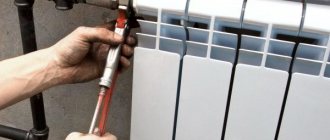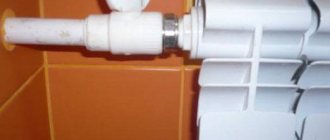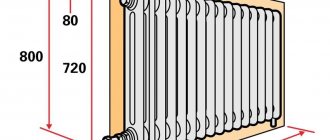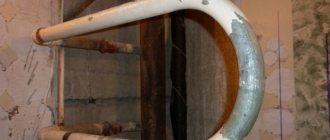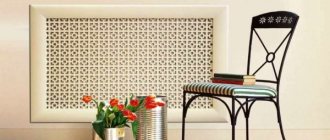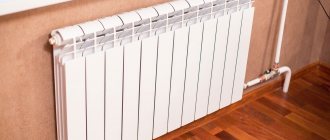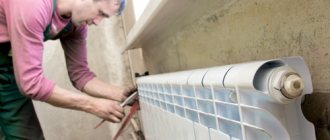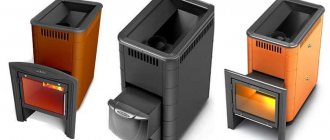In the modern construction market you can find a lot of different heating radiators. They can be steel, aluminum or bimetallic. The oldest type of heating appliances are cast iron radiators. Experts say that such devices have not lost their popularity to this day.
Note! The main advantage of heating radiators made of cast iron is their immunity to corrosion and chemical impurities. The service life of such devices is at least 50 years.
How much does one section weigh?
For many builders, the term “cast iron heating radiator” is associated with a heavy structure. Indeed, on the construction market you can find a huge number of heating devices in question, and their weight varies over a fairly wide range. According to experts, the heating radiator section, which was used during the Soviet Union, has a mass of just over 7 kilograms. If water is poured into this container, the weight of the section will increase to 8.6 kilograms.
At that time, a standard heating radiator consisted of 6 sections, which means that the weight of each battery without water was within 43 kilograms . If we take into account that the thermal power of each of the individual sections is within 170 watts, then two such radiators will be needed for a room with a total area of 20 m2.
Connecting sections in a cast iron radiator
Modern analogues of cast iron heating devices have much less weight than the batteries that were used during the Soviet era. For example, the weight of a single section of a Czech heating device is 3.8 kilograms. This container contains 800 milliliters of water, which increases the weight to 4.6 kilograms.
If we take into account the thermal efficiency of each section within 140 watts, then for a room with a usable area of 20 square meters you will need 14 such sections. With detailed calculations, one can easily determine that the weight of such a device is 40% less than the mass of its Soviet counterpart.
Is it worth replacing cast iron batteries with bimetallic ones?
The issue of replacing cast iron batteries with bimetallic analogues should be approached with particular seriousness. The fact is that the first heating devices have many useful characteristics:
- Long period of operation - at least 50 years;
- Corrosion resistance;
- Possibility of heating indoor air at a minimum coolant temperature of 55 degrees;
- High thermal inertia.
Bimetallic radiator
As we can see, cast iron heating radiators, despite their significant weight and unpresentable appearance, perform their functions perfectly. People who replace cast iron batteries with bimetallic heating devices have the goal of camouflaging the batteries in the general environment.
The second reason for changing radiators is considered to be automation of the heating process and cleaning the system of contaminants. It should be noted that during operation, cast iron batteries become clogged with dirt, which leads to uneven heating.
Note! When replacing heating devices, special attention should be paid to water quality. The presence of harmful impurities leads to premature failure of aluminum radiators.
Advantages and disadvantages
Like any metal heating devices, cast iron radiators have positive and negative sides.
pros
- Low inertia. The thick walls of the radiator heat up slowly, but also cool down slowly. In the harsh climatic conditions of Russia, this is a big plus. But for regions with a mild climate, there is an inconvenience in terms of regulating heat transfer.
- Preparation of the coolant, when it comes to central heating, takes place in boiler rooms. Unfortunately, the coolant cannot boast of high quality indicators. But cast iron batteries cope with this problem easily. They can withstand even highly alkaline solutions.
- Huge service life. Everything happens by reducing corrosion processes. This metal reacts well to water, practically unchanged under its influence.
- Minimum hydraulic resistance. For apartments in whose heating networks water flows at high speed, this is the best option.
- Even deposits of scale and impurities do not affect the quality of operation of a cast iron appliance. It's all about the channels, which are quite large in size.
Minuses
- Large size and heavy weight. All this complicates the processes of installing cast iron batteries, transferring, unloading and loading.
- The rooms are slowly heating up.
- Not very presentable appearance. True, this problem is easily solved. One has only to hang a decorative screen on a cast-iron heating radiator, and the issue is closed.
The biggest disadvantage is the difficulty of repairing and installing cast iron heating radiators. There are several strict requirements that must be taken into account. One of them is the exact installation location. Experts believe that certain standard distances from the surfaces of the floor, wall and window sill make the entire heating system as a whole operational. There are, of course, some deviations, but they are minimal. Large deviations in one direction or another of one of the batteries can lead to a failure in the system. In some rooms the radiator will be very hot, in another it will be warm.
Here are the standard distances:
- from the floor or window sill on average 7 cm, plus or minus 2 cm;
- from the wall 4 cm, plus or minus 1 cm.
It is not difficult to set the device exactly according to the specified dimensions. But you will need patience and skill in working with tools (plumb line, level, tape measure). Once the location has been determined, the cast iron radiator can be mounted.
What is a cast iron radiator made of?
Which batteries are better - cast iron or aluminum?
Cast iron heating radiators need no introduction, which cannot be said about heating devices made of aluminum. To determine which of these types of devices is better, we will describe the advantages and disadvantages of each of them.
The advantages of cast iron batteries include:
- Resistance of the material to corrosion. According to experts, cast iron is not afraid of abrasive substances such as sand and other debris. It is also not destroyed by acids;
- Such devices are low in cost and have high thermal output;
- Such products can last up to 50 years.
Modern cast iron radiators
Despite the significant number of advantages, the described devices also have disadvantages. The main disadvantages of heating devices made of cast iron:
- Possibility of water hammer and disruption of the system;
- Insufficient thermal conductivity of the material;
- Ugly appearance, although modern analogues are very attractive, but their price is high.
Today, aluminum heating radiators are very popular among consumers. They have small dimensions and weight compared to analogues. When using aluminum radiators, automatic heating control becomes possible.
Note! Aluminum has a much higher thermal conductivity coefficient than cast iron. This means that such devices will heat up faster and release heat into the room.
The disadvantages of the described devices include low corrosion resistance and limited strength of the products. The service life of such devices will depend on the degree of purification of the coolant. The optimal acidity level should be between 7 and 8 pH.
Aluminum radiator
There is no clear answer to the question of which batteries are better. Here everyone chooses according to personal preferences. Recently, more and more users are leaning toward aluminum radiators, because such devices are much lighter and more compact than their analogues.
When using such devices, it becomes possible to automatically control heating. At the same time, cast iron batteries have a long service life, suffer less from poor-quality coolant, and are not afraid of corrosion.
How cast iron batteries work and work
Cast iron radiators are arranged in sections. Each section has internal channels for the coolant. Externally, the sections look like metal columns. All sections are connected to each other by a nipple system. And all joints are sealed with rubber or paronite gaskets. The depth of the battery can be from 65 to 500 mm, and the height can be from 350 to 1500 mm.
Such radiators are usually installed under window sills. There are batteries that are mounted on legs, but more common models are hung on special brackets that are mounted into the wall.
The power of the heating device depends on the heat output area and the number of sections. Power can be from 100 to 300 W. This value depends on the heating radiator model. Some of the heat is transferred using the convective method, and from 25 to 35% of the heat is transferred using radiation. In addition to air, the heating battery also heats appliances due to radiation. Therefore, heating the room is more efficient. Warm layers of air heat the upper part of the room, and the lower part is heated by radiation. With such a heating system, the maximum comfortable atmosphere in the room is obtained.
How to rinse at home
In country houses, the heating system often loses its efficiency. This happens through poor heat transfer, as well as as a result of debris settling on the walls of the batteries. The coolant heated to a high temperature affects the inside of the radiators, where scale and rust settle. The presence of blockages leads to poor heating of the building.
The main reasons for flushing batteries are:
- Uneven heating of the radiator over the entire plane, when the upper part of the sections is hot, but the bottom of the tank remains cold;
- Warming up the heating system to the required temperature takes longer than usual;
- Increased fuel consumption.
To independently flush heating devices, aluminum or cast iron radiators, you need to drain the water and unscrew the radiator from the system. Removing blockages or flushing occurs using clean water with the addition of acetic acid, special cleaning agents or caustic soda.
Battery before and after washing
It is advisable to carry out the work in the bathroom to prevent liquid from spilling onto the floor. At the same time, a mesh is installed in the bathroom drain hole to collect large contaminants. Pre-placed rags will help prevent damage to the container's coating.
At the initial stage of work in cast iron radiators, all plugs are unscrewed, and water heated to a boil is poured into the resulting holes. Next, shake out the heating device and drain the liquid and debris.
Next time, water with the selected cleaning agent is poured into the radiator. After this, close all the plugs, knock on the device with a wooden hammer, shake it and pour out the water. Similar operations are carried out until clean liquid flows from the holes.
Assembling a cast iron heating radiator
Before assembly, first of all, it is necessary to clean the threads of all sections from traces of packing material and jute. To do this, you can use a wire brush, kerosene and rags.
The quality of the thread must be checked by testing new nipples and plugs. The assembly procedure is shown in the diagram.
Before assembly, each glass is treated with Tsiatim or graphite, wrapped in jute tow and screwed into the body of the register by one thread.
You only need to collect it on the table
Install the o-ring on top, the next battery register and align along the axis. After which you can turn it with a key. If the thread “does not work,” then it is better to disassemble it and try to determine the cause. Assembly is performed with minimal effort.
Heating element for cast iron battery
A heating element mounted in a cast iron radiator allows you to warm up the room when it is not possible to start the heating system in the usual way. The heating element itself is nothing more than a metal pipe with a spiral sealed in the middle. When installing a heating element in a cast iron radiator, you can achieve optimal temperature values in a small room: garage, kitchen, greenhouse or any other outbuilding.
Heating element for radiator
The main advantages of electric heating elements:
- Possibility of installation in a battery made of cast iron and other materials;
- Automatic control of water heating temperature;
- Using a heater as the main heat source;
- Easy to install.
Note! The heating element installed in the heating device makes it possible to protect the system from defrosting in the event of a failure in the heat supply.
Anyone can install the described device. The heating elements are equipped with temperature control mechanisms and overload protection. The heater just needs to be installed in the radiator socket and connected to a power source. Before operating the heating element, the heating system must be completely filled with water or another type of coolant.
The heater in the radiator must be in a horizontal position. It usually works in two modes. If the device is used in the system as the main heating source, then the room will warm up to the set temperature, and a special thermostat will maintain the temperature at the specified parameters.
Connection to a cast iron battery
If the heating element is used in a country house or in an auxiliary room, then the main task of the heater will be considered to be minimal heating of the system to protect against freezing. In this case, the device is set to minimum power.
Operational features of cast iron batteries (video)
Well, cast iron batteries have come a long way and have been used in our homes for more than a century. They are heavy, rough and do not have the best heat loss properties, but they offer a long-lasting heating effect and an extremely long service life. Cast iron radiators do an excellent job of warming up the house and preventing it from cooling down quickly, so they still deserve their place on the market. The main competitors of cast iron radiators are aluminum, steel and bimetallic.
Among heating devices, the most common are heating radiators. The heating radiator design can be either sectional or panel. Such elements are made from different materials - it can be cast iron, steel, and alloys. Their appearance and aesthetics can currently be completely different, but heating radiators also differ in design features.
Life time
The first mention of a cast iron battery dates back to 1857, when the famous Russian engineer Franz Sangalli made the first cast iron radiator from a piece of pipe. A special feature of his invention were protruding fins, which were used to remove accumulated heat. After some time, the appearance of the cast iron radiator changed, it took on the appearance of an accordion.
For a long time, heating devices made of cast iron were the main ones in civil and industrial buildings in Russia. One of the advantages of cast iron radiators is their long service life. According to experts, such a battery can be used for 50 years, but this requires periodic maintenance of the system. It consists of washing the sections and replacing the gaskets between the blocks.
What is the price
The cost of cast iron radiators will depend on the overall dimensions of the product, manufacturer and brand. The oldest model of domestic production is considered to be MC 140. A separate section of such a battery costs an average of 340 rubles per piece, the price depends on the markup of resellers and the region.
Also, cast iron batteries from foreign manufacturers (Italy, Czech Republic, Spain, Turkey) are supplied to the domestic market. Such devices differ from domestic ones in various respects. For example, the capacity of the section of the Czech Termo battery is almost two times smaller - 800 milliliters, while the domestic MS 140 holds 1.4 liters of water.
Radiator Nostalgia (retro) in the interior
The price of one section of foreign cast iron radiators in rubles is as follows:
- Brand Kiran 92/500 – from 335 rubles;
- Manufacturer Viadrus termo 500/95 – no less than 450 rubles;
- Company Nostalgia (retro) 500/180 – from 2120 rubles;
- Demrad 350 brand – no less than 400 rubles per section.
How to paint
If it is not possible to replace old cast iron batteries with more modern heating devices, many people repaint the radiators in the desired color. The entire painting process can be divided into several stages:
- Selection of paint;
- Surface cleaning;
- Paint application;
- Drying the product.
To treat such surfaces, it is recommended to use alkyd dyes, heat-resistant varnish with the addition of bronze or aluminum powder. In addition, for such work you can use water-based paint, to which you can add various pigments to obtain the desired color.
At the initial stage of work, working tools are prepared and the surface of heating devices is cleaned. This can be done using a wire brush, coarse sandpaper or an angle grinder equipped with a special attachment. To facilitate the work, special solutions are used that help destroy the old coating.
Note! When using solvents, be sure to ventilate the room and use a respirator to protect your respiratory system.
The washing liquid is applied to the surface using a brush. After leaving for a certain time indicated on the solvent packaging, the old layer of paint will begin to wrinkle and peel off. The coating can be removed with a small metal spatula. The final cleaning of the battery is carried out using a metal brush.
At the next stage of work, the radiator is thoroughly cleaned with sandpaper and primed, which will help the paint adhere better. The best type of primer is considered to be the GF021 brand; it is suitable for any type of dye.
Next, a layer of paint is applied using a paint brush. The composition is applied carefully from top to bottom. For better coloring, the dye is applied in several layers. In this case, you need to take a break between the stages of applying the coloring composition.
Operational features and advantages of cast iron batteries
Why is cast iron more acceptable in heating systems? Let's take a closer look at its characteristics. The features of cast iron as a metal are very interesting.
Namely:
- It has low thermal conductivity, which means it heats up very slowly. In order to heat the batteries to a temperature of 45 degrees, you need to turn on the water at a temperature of 75 degrees. However, when the batteries get hot, this effect comes to our advantage. Warm cast-iron radiators can hardly be cooled by anything, and walls frozen through in winter do not create problems.
- The second feature is durability and versatility. Due to their bulkiness, cast iron batteries have been written off by many as a “dustbin of the past”, but in vain. After all, alas, there is nothing better than this metal for radiators yet. Some engineers ironically claim that cast iron batteries are generally eternal and it is worth noting that they are not so far from the truth. Not everyone these days has the opportunity to change old batteries, but even 60-year-old cast iron radiators do not break through. Grandmothers living in Khrushchev-era apartment buildings with batteries as old as the world do not even think about their possible replacement. Batteries are perceived as something eternal, unshakable, and their service life can actually be almost 100 years. And now, for comparison, the service life of aluminum batteries is up to 20 years.
- The third thing that makes cast iron batteries so interesting is the lack of headaches regarding maintenance. Cast iron batteries will almost never require repairs or even preventive measures; they are the only type of radiators in which rusty, dirty water can easily circulate without any consequences. Unfortunately, our realities are such that the water in the pipes is really far from crystal clear, so in this regard, cast iron batteries provide insurance.
